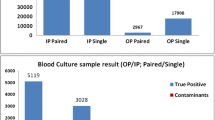Abstract
Blood culture is a laboratory test where a blood specimen, taken from a patient, is inoculated into bottles containing culture media to determine if infection-causing microorganisms (bacteria or fungi) have invaded the patient’s bloodstream. This test is an important investigation with major implications for the diagnosis and treatment of patients with bloodstream infections and possible sepsis. Moreover, blood culture will also provide the etiologic agent for antimicrobial susceptibility testing, enabling optimization of antibiotic therapy with significant impact on the outcome of the disease. Even if the potential benefices of blood culture are well known, critical factors mainly in pre- and post-analytical phases can reduce the clinical value of this test.
Access this chapter
Tax calculation will be finalised at checkout
Purchases are for personal use only
Similar content being viewed by others
References
Paolucci M, Landini MP, Sambri V (2010) Conventional and molecular techniques for the early diagnosis of bacteraemia. Int J Antimicrob Agents 36(Suppl 2):S6–S16
Towns ML, Jarvis WR, Hsueh PR (2010) Guidelines on blood cultures. J Microbiol Immunol Infect 43(4):347–349
Munson E, Diekema DJ, Beekmann SE, Kimberle C, Chapin KC, Doern GV (2003) Detection and treatment of bloodstream infection: laboratory reporting and antimicrobial management. J Clin Microbiol 41:495–497
Wayne PA (2007) Principles and procedures for blood cultures; approved guideline, CLSI document M47-A. Clinical and Laboratory Standards Institute (CLSI)
Garey KW, Rege M, Pai MP, Mingo DE, Suda KJ, Turpin RS, Bearden DT (2006) Time to initiation of fluconazole therapy impacts mortality in patients with candidemia: a multi-institutional study. Clin Infect Dis 43(1):25–31
Khatib R, Saeed S, Sharma M, Riederer K, Fakih MG, Johnson LB (2006) Impact of initial antibiotic choice and delayed appropriate treatment on the outcome of Staphylococcus aureus bacteremia. Eur J Clin Microbial Infect Dis 25(3):181–185
Saito T, Iinuma Y, Takakura S, Nagao M, Matsushima A, Shirano M, Ichiyama S (2009) Delayed insertion of blood culture bottles into automated continuously monitoring blood culture systems increases the time from blood sample collection to the detection of microorganisms in bacteremic patients. J Infect Chemother 15:49–53
Weinstein MP (2003) Blood culture contamination: persisting problems and partial progress. J Clin Microbiol 41:2275–2278
Baron EJ, Weinstein MP, Dunne WM, Yagupsky P, Welch DF, Wilson DM (2005) Cumitech 1C, blood cultures IV. In: Baron EJ (ed). ASM, Washington, DC
Cockerill FR 3rd, Wilson JW, Vetter EA, Goodman KM, Torgerson CA, Harmsen WS, Schleck CD, Ilstrup DM, Washington JA 2nd, Wilson WR (2004) Optimal testing parameters for blood cultures. Clin Infect Dis 38:1724–1730
Bourbeau PP, Foltzer M (2005) Routine incubation of BacT/ALERT FA and FN blood culture bottles for more than 3 days may not be necessary. J Clin Microbiol 43:2506–2509
Riedel S, Bourbeau P, Swartz B, Brecher S, Carroll KC, Stamper PD, Dunne WM, McCardle T, Walk N, Fiebelkorn K, Sewell D, Richter SS, Beekmann S, Doern GV (2008) Timing of specimen collection for blood cultures from febrile patients with bacteremia. J Clin Microbiol 46(4):1381–1385
Riley JA, Heiter BJ, Bourbeau PP (2003) Comparison of recovery of blood culture isolates from two BacT/ALERT FAN aerobic blood culture bottles with recovery from one FAN aerobic bottle and one FAN anaerobic bottle. J Clin Microbiol 41:213–217
Søgaard M, Nørgaard M, Schønheyder HC (2007) First notification of positive blood cultures and the high accuracy of the gram stain report. J Clin Microbiol 45(4):1113–1117
Fraser A, Paul M, Almanasreh N, Tacconelli E, Frank U, Cauda R, Borok S, Cohen M, Andreassen S, Nielsen AD, TREAT Study Group (2006) Benefit of appropriate empirical antibiotic treatment: thirty-day mortality and duration of hospital stay. Am J Med 119:970–976
Kumar A, Roberts D, Wood KE, Light B, Parrillo JE, Sharma S, Suppes R, Feinstein D, Zanotti S, Taiberg L, Gurka D, Kumar A, Cheang M (2006) Duration of hypotension before initiation of effective antimicrobial therapy is the critical determinant of survival in human septic shock. Crit Care Med 34(6):1589–1596
Dunne WM, Nolte FS, Wilson ML (1997) Cumitech 1B, blood cultures III. In: Hindler JA (ed) ASM, Washington, DC
Roth A, Wiklund AE, Pålsson AS, Melander EZ, Wullt M, Cronqvist J, Walder M, Sturegård E (2010) Reducing blood culture contamination by a simple informational intervention. J Clin Microbiol 48(12):4552–4558
Washer LL, Chenoweth C, Kim HW, Rogers MA, Malani AN, Riddell J 4th, Kuhn L, Noeyack B Jr, Neusius H, Newton DW, Saint S, Flanders SA (2013) Blood culture contamination: a randomized trial evaluating the comparative effectiveness of 3 skin antiseptic interventions. Infect Control Hosp Epidemiol 34(1):15–21
Suwanpimolkul G, Pongkumpai M, Suankratay C (2008) A randomized trial of 2 % chlorhexidine tincture compared with 10 % aqueous povidone-iodine for venipuncture site disinfection: effects on blood culture contamination rates. J Infect 56(5):354–359
Li J, Plorde J, Carlson L (1994) Effects of volume and periodicity on blood cultures. J Clin Microbiol 32:2829–2831
Connell TG, Rele M, Cowley D, Buttery JP, Curtis N (2007) How reliable is a negative blood culture result? Volume of blood submitted for culture in routine practice in a children’s hospital. Pediatrics 119(5):891–896
Rubenstein E, Lang R (1995) Fungal endocarditis. Eur Heart J 16(Suppl B):84–89
Ellis ME, Al-Abdely H, Standridge A, Greer W, Venturea W (2001) Fungal endocarditis: evidence in the world literature, 1965–1995. Clin Infect Dis 32:50–62
McLeod R, Remington JS (1978) Fungal endocarditis. In: Rahimtoola SH et al (eds) Infective endocarditis. Gune & Stratton, New York, NY, pp 211–290
Author information
Authors and Affiliations
Corresponding author
Editor information
Editors and Affiliations
Rights and permissions
Copyright information
© 2015 Springer Science+Business Media New York
About this protocol
Cite this protocol
Pardini, G. (2015). Technical Improvements in Culturing Blood. In: Mancini, N. (eds) Sepsis. Methods in Molecular Biology, vol 1237. Humana Press, New York, NY. https://doi.org/10.1007/978-1-4939-1776-1_4
Download citation
DOI: https://doi.org/10.1007/978-1-4939-1776-1_4
Published:
Publisher Name: Humana Press, New York, NY
Print ISBN: 978-1-4939-1775-4
Online ISBN: 978-1-4939-1776-1
eBook Packages: Springer Protocols




